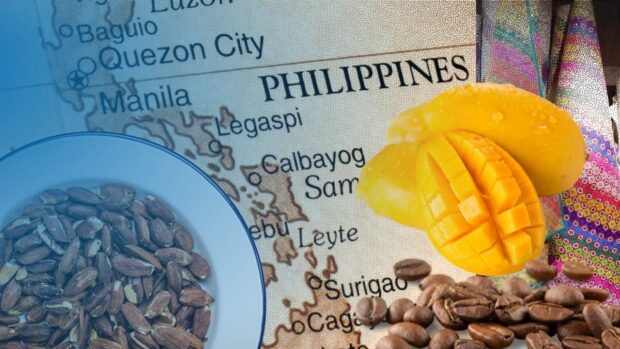MANILA, Philippines — Distinctly Philippine-made products, such as Batangas’ “barako” coffee, Guimaras’ mangoes, Bicol’s “pili” nut, Cordillera’s heirloom rice, and Southern Luzon’s “lambanog” (coconut wine), may soon be protected from intellectual property (IP) violations.
The Intellectual Property Office of the Philippines (IPOPHL) on Monday said it had identified 31 potential geographical indications (GIs), a type of IP coverage linked to local heritage and qualities or characteristics attributable to a specific place, in a bid to better protect and promote the country’s local products.
Once registered, local communities or groups which registered their products’ GI are assured of the IPOPHL’s assistance in the mediation or adjudication of administrative cases that may arise regarding their goods. The Integrated Bar of the Philippines (IBP) will also extend pro bono assistance.
The IPOPHL said that the “ube kinampay” (purple yam) and the “asin tibook” (artisanal sea salt) are the newest addition to the Bureau of Trademarks’ (BOT) list.
The IP rights body recently met with producers of these products that are known to be concentrated in the province of Bohol to help them learn about the benefits of IP protection.
Quality assurance
“Branding your products assures consumers of the quality, and this in turn will create demand and opportunities for better market access and revenue generation,” said BOT Director Jesus Antonio Ros during their workshop from March 13 to March 14.
The IPOPHL has also identified six other potential GIs from the Visayas aside from Guimaras mangoes. These are Aklan’s “piña” (pineapple) cloth, Antique’s Bagtason loom and Tibiao piña fiber, Samar’s Basey “banig,” Cebu’s dried mangoes and Tuburan coffee.
From Luzon, it is also looking at the Benguet cacao and strawberry, the Bonoan (Dagupan) “bangus,” the Buhi weave of Camarines Sur, the Kalinga coffee, the Laguna coffee, the lambanog of Quezon, Batangas and Laguna provinces, the Liliw (Laguna) footwear, the Lumban (Laguna) embroidered “barong,” the Masbate beef and Milagros Carmelado (carabao milk candy), the Paete (Laguna) woodcarvings, the Calauan (Laguna) pineapple and Aurora province’s sabutan weave.
IPOPHL has also included Camiguin’s lanzones, Davao’s cacao and pomelo, Lake Sebu’s (South Cotabato) T’nalak weave and the Yakan cloth (Zamboanga and Basilan)—all of which are from Mindanao.
Ros earlier said that the agricultural and handicraft sectors would benefit the most from this measure, which is expected to promote traditional and indigenous Philippine products.
Unlike trademarks, where an application is filed by an individual or a single entity, GIs must be registered under an association of producers that are directly involved in the production, engaged in its trade, or in charge of regulating or protecting GIs.
